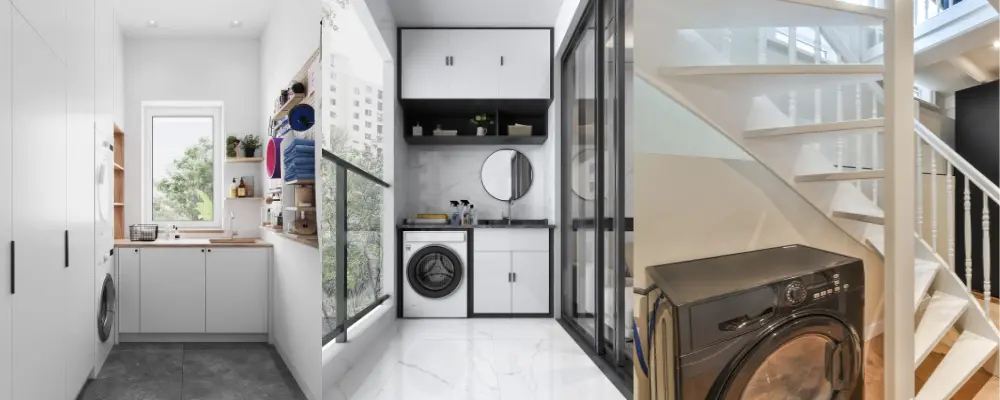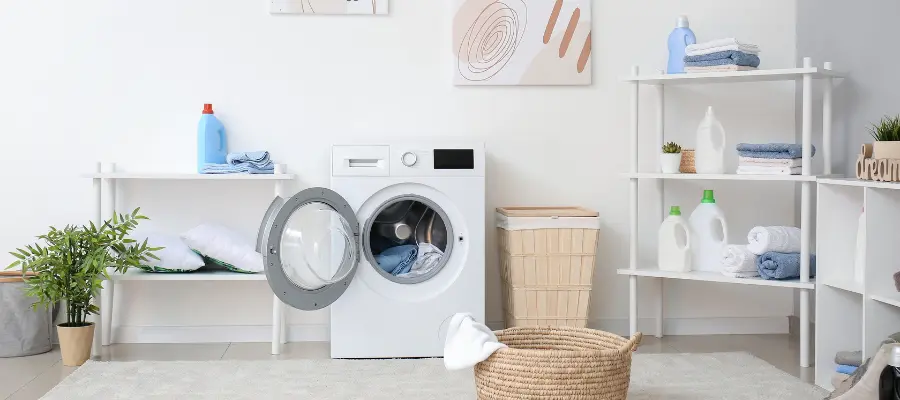Whenever you spill coffee on your shirt, the first thing that pops into your head is the laundry room. It’s not just a place to wash clothes — it’s a chill zone where your dirty laundry gets a fresh new life. Are you also considering including a laundry room in your house?
Then, read this blog to understand more about laundry room design.
What is a Laundry Room?
You can think of a laundry room as a room designed for washing and drying clothes, with sufficient space for laundry machines and extra storage for laundry items. Depending on the layout and the available floor area, laundry rooms commonly include an additional sink, ironing board, storage cabinets, and countertops for folding clean clothing. The main reason behind this room is to centralise laundry-related tasks in an organised way separate from other living spaces.
Essential Elements of a Laundry Room
Based on the layout and the available floor area of your home, a laundry room commonly includes the following essential elements:
Washing Machine with In-Built Dryer Option: A washing machine with an in-built dryer is the best for homes, as it combines both washing and drying functions in a single unit. You don’t need a separate dryer, and you can save valuable floor space.
Storage Solutions: You must have sufficient storage options inside a laundry room. You can include shelving units, cabinets, and hampers to organise your laundry area. For space constraint cases, you can include vertical space with shelves. Always include separate dustbins to separate wastes.
Counter Space: You will require a countertop or a folding surface to fold and sort dried cloth. This will help you to keep the laundry space organised.
Laundry Sink: A separate sink in the laundry room will be helpful for washing delicate items, pre-soaking stained clothes, or rinsing muddy garments before putting them into the washing machine.
Drying Rack or Clothesline: You place drying racks or retractable clotheslines to air-dry delicate clothes that cannot go in the dryer to maintain the quality of fabric and look new.
Laundry Room Layout Ideas

When planning to create a laundry room layout in your home, you can easily find various innovative layouts and design strategies. You can see some of the following laundry room ideas:
Under-Staircase Laundry Room
If you have empty space under your stairs, you can turn it into a small laundry area. You can add a door or leave it open, depending on your budget and how much space you have. If you want it to look neat, choose a door that matches your wall or room style. To store things better, you can add pull-out drawers or shelves. You can pick a swing, folding, or sliding type for the door—whichever works best for the space.
Balcony Laundry Design
When you have a balcony space, you can include a laundry room to make the area more multifunctional. However, carefully measure the space to ensure it’s sufficient for the washing machine and storage options. The balcony laundry layout should look neat and tidy. You can include utility worktops, internal shelves, cupboards, and more. The theme of the balcony laundry area should match the rest of your house to maintain visual continuity. Good drainage, ventilation, heating, and electrical wiring systems can be connected to the existing indoor setups. You can also add decor elements like colourful tiles or cheerful paint to make the balcony laundry area visually appealing, even with its outdoor exposure.
Mudroom Laundry
You can optimise the space in small houses by integrating a mudroom with laundry. This way, you can keep washing machines along with shelves for cleaning supplies, bedsheets, and outdoor items in one place. You can add open racks, or wall-mounted dryers that can be folded when not in use. Open shelves help you reach daily items easily and keep things tidy. With good planning, this room can make everyday work easier and more organised.
Laundry Space in the Bathroom
You can combine the bathroom with laundry space. In a bathroom/laundry combo, you must choose the right appliances and fixtures with the correct size for your bathroom. Make sure to select appliances that are the correct size for your bathroom. When designing a bathroom laundry room combo, it’s important to plan carefully to make the space both functional and stylish. Start by making sure all plumbing work is done correctly and follows safety rules to avoid leaks. Choose durable, easy-to-clean materials like ceramic tiles for the floor and walls, and consider quartz or granite for countertops. Storage is also key—add shelves, cabinets, or built-in units to keep laundry items and bathroom essentials organized. By picking the right colours, finishes, and smart storage solutions, you can create a neat, practical, and attractive multi-use space.
Attic Laundry Room
Compared to other spaces, an attic laundry room is more difficult to organise, as attics generally have odd dimensions that complicate the design, and laundry rooms have very specific requirements. Make sure to consider reinforcement in attic floors to support heavy appliances, with proper ventilation, and installing adequate insulation to manage temperature swings. Customise storage solutions, such as built-in shelves or drawers under sloped ceilings, help keep the space uncluttered and efficient.
Best Materials & Finishes for Indian Laundry Rooms
Laundry Room Flooring
Whenever you are designing a laundry room, you need to consider flooring as a major aspect. It should always be non-slippery and strong enough to withstand heavy appliance loads. As you often use chemicals, water and detergents regularly, the floor should be capable of withstanding all. You can include vinyl flooring, tile, and concrete based on your budget requirements.
Laundry Room Wall Finishes
Walls also should be resistant to moisture content and humidity. You can use stain-resistant paints, such as acrylic or epoxy-based paints. These can offer a washable and moisture-resistant surface. Ceramic tiles are commonly selected for their superior water resistance, ease of maintenance, and long-lasting finish, mainly in high-moisture areas.
Laundry Room Countertops
Laundry room countertops should be resistant and durable against moisture content. Stone surfaces like granite and quartz are excellent choices with high durability, stain resistance, and an elegant appearance. If you are in search of a budget-friendly option, you can go for laminate countertops with decent moisture resistance and a variety of design options, though they may not be as durable as stone surfaces.
Laundry Room Cabinets
Cabinetry in laundry rooms should be made from materials that can handle humidity. Moisture-resistant plywood is commonly used for its strength and longevity, especially when finished with laminates or waterproof coatings. PVC cabinets are also popular for their complete resistance to moisture, ease of cleaning, and affordability, making them suitable for Indian conditions.
Selecting these materials ensures your laundry room remains functional, easy to maintain, and visually pleasing for years to come.
Smart & Modern Laundry Room Features
Smart Appliances
Wi-Fi-enabled washers and dryers allow remote control and monitoring via smartphone apps. With this option, users can receive cycle notifications and optimise energy consumption, making laundry routines more convenient and efficient.
Foldable Drying Racks
Wall-mounted, foldable drying racks save valuable floor space. They offer a discreet and practical solution for air-drying clothes, mainly in compact Indian homes.
Hidden Ironing Boards
Ironing boards that fold away into cabinetry or drawers help maintain a clutter-free and modern look. They are space-saving and easily accessible when needed.
Automated Detergent Dispensers
These dispensers ensure the right amount of detergent is used for each load, reducing waste and improving wash quality. They offer convenience and consistent cleaning results.
Energy-Efficient Lighting
Proper ventilation prevents dampness and mould, while good lighting—such as under-cabinet or ceiling lights—ensures visibility and safety when handling laundry tasks. LED lighting and motion sensors reduce electricity consumption while providing bright, efficient illumination.
Common Mistakes to Avoid while Designing a Laundry Room
When people ask, “How to plan a laundry room ?” Experts ask them to concentrate on “how not to” by avoiding these laundry room design mistakes:
Poor Ventilation
Improper ventilation can lead to moisture build-up and mould growth, especially in compact or windowless laundry rooms. Always install a ventilation fan or ensure there is a window to prevent condensation and maintain air quality.
Inadequate Electrical/Water Points
Not planning enough electrical outlets or water connections can limit appliance placement and functionality. Ensure your layout includes sufficient and conveniently located points for all appliances and accessories.
Ignoring Ergonomics
Placing machines too low or designing storage that requires excessive bending can make daily tasks uncomfortable. Locate appliances and storage at accessible heights to improve comfort and efficiency.
Overcrowding with Unnecessary Items
Don’t just fill the space with too many cabinets, baskets, or unnecessary items. This can make the room feel cramped and restrict movement. Always prioritise essential storage and keep the layout open for easy workflow.
You can design a modern laundry room by bringing in an expert construction company. They can help place it in the best spot in your house and handle the construction and finishing work to match your budget and needs. For customisation, you can share your ideas and take their suggestions too.

